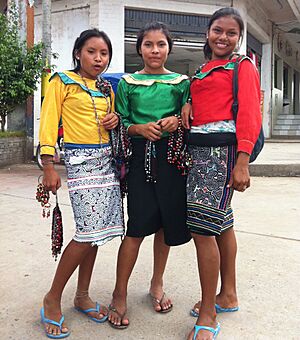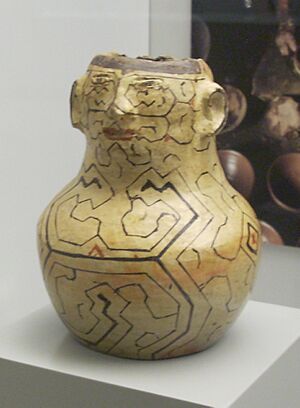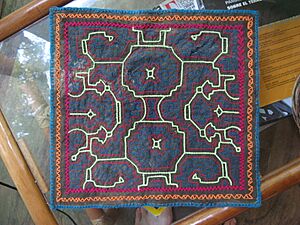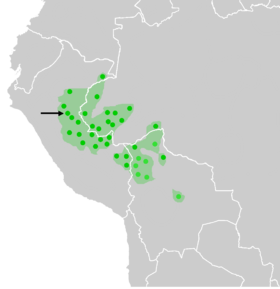Shipibo-Conibo facts for kids

Three Shipibo girls in Pucallpa wearing traditional textiles
|
|
| Total population | |
|---|---|
| 11,000-25,000 | |
| Regions with significant populations | |
| Languages | |
| Shipibo, Spanish | |
| Religion | |
| Christian, Animism | |
| Related ethnic groups | |
|
The Shipibo-Conibo are a group of indigenous people who live along the Ucayali River in the Amazon rainforest in Peru. They used to be two separate groups, but they joined together through marriage and shared traditions. Now, they are known as the Shipibo-Conibo people.
Contents
Shipibo-Conibo Life and Traditions
The Shipibo-Conibo people have lived in the Amazon rainforest for thousands of years. Many of their old traditions are still important today. Their special songs have inspired the beautiful art they create. You can see these designs on their clothes, pottery, tools, and woven items.
Some Shipibo-Conibo people live in cities like Pucallpa in the Ucayali region. This area is a large zone for indigenous groups. Most others live in small villages spread out across a big part of the jungle. This jungle area stretches from Brazil to Ecuador.
Art and Food
Shipibo-Conibo women are skilled at making beadwork and textiles. They are also famous for their pottery. This pottery is decorated with unique maze-like patterns in red and black. In the past, they made these ceramics for use in their homes. Today, selling their crafts to tourists helps many families earn extra money.
They also make a sweet drink called chapo. It is made from plantains. The Shipibo people in the village of Paoyhan used to eat a lot of fish, yuca (a root vegetable), and fruits. However, global weather changes have made this harder. Droughts followed by floods have killed many fruit trees. Some banana and plantain trees are also struggling.
Outside Contact and Beliefs
Over the last 300 years, the Shipibo have had only occasional contact with the outside world. This includes the governments of Peru and Brazil. The Shipibo people are known for their rich and complex beliefs about the universe. These beliefs are closely connected to the art and items they create. Christian missionaries, especially the Franciscans, have worked to share their religion with the Shipibo since the late 1600s.
Population and Challenges
There are more than 20,000 Shipibo-Conibo people. They make up about 8% of the registered indigenous population in Peru. It can be hard to get exact numbers because many people move around. A large number of Shipibo-Conibo have moved to cities. These cities include Pucallpa and Yarinacocha District in eastern Peru. They move to get better education and health care. They also look for new ways to earn money.
The number of Shipibo-Conibo people has changed over the years. In 1978, there were about 11,000. By 1994, the number grew to as many as 25,000.
Like other indigenous groups in the Amazon, the Shipibo-Conibo face challenges. These include pressure from things like oil exploration, logging (cutting down trees), and efforts to protect nature.
See also
 In Spanish: Shipibo-conibo para niños
In Spanish: Shipibo-conibo para niños
- Guillermo Arévalo
- Shipibo language
- Santa Clara de Uchunya v. Plantaciones de Pucallpa and the Regional Government of Ucayali




